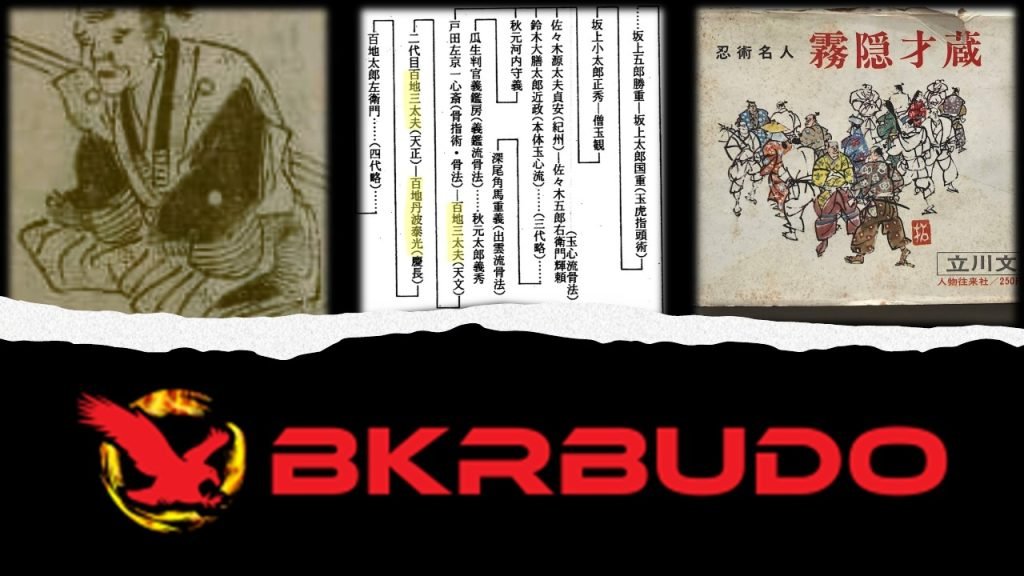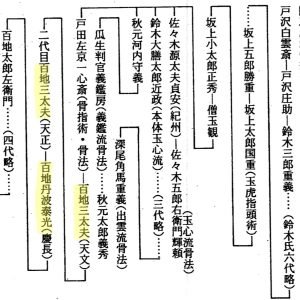Momochi Tanba, also known as “Momochi Sandayu,” emerges as a prominent figure from the Warring States period, renowned as one of the three great jonin of Iga. While the name “Momochi Sandayu” is often woven into the fabric of ninja legends, the historical records surrounding Momochi Tanba are scant, leaving much of his life in obscurity. As some of you may know Momochi Sandayu the 1st, Momochi Sandayu the 2nd and Momochi Tanba Yasumitsu are accredited as being past headmasters of the Gyokko Ryu during the Warring States period before the art was passed into the Toda family. I have included a photo of part of the lineage chart for the Gyokko Ryu with their names highlighted in yellow.
His influence in Iga Province during the 1570s is well established, yet the details of his ninja/shinobi activities remain veiled in mystery. Leading a shinobi unit alongside the Hattori and Fujibayashi families, Momochi Tanba is often credited as one of the founders of Iga-ryu Ninjutsu. Delving into historical facts, let us unveil the true narrative of Momochi Tanba.
The birth and death years of Momochi Tanba remain elusive, but his active years in the 1570s, within southern Iga, coincided with the ambitious rise of Oda Nobunaga, who sought to unify the nation. This era witnessed the invasion of Iga by Nobunaga, disrupting the established order of the independently governed region, a realm that Momochi and others had diligently maintained.
Born in Nabari, Iga Province, as the legitimate son of Momochi Seiemon, Momochi Tanba grew up in an environment surrounded by steep cliffs. The demanding terrain of Iga forged resilient individuals, their sturdy legs a testament to the rugged landscapes.
Engaging in daily training and serving warlords, Iga shinobi or “Iga-mono” as they were known at the time, assumed diverse roles within society. The hierarchical structure of Jonin, Chunin, and Genin delineated their ranks, with Genin as frontline combatants and Chunin as their commanding officers.
The Hattori, Fujibayashi, and Momochi families, collectively known as the three great jonin, led the Iga ninja group. During the Warring States period, Fujibayashi Nagato, whose family originated from Mt. Togakushi (of the Togakure Ryu) governed the northern half of Iga, while Momochi Tanba ruled the southern half. Despite internal conflicts, they forged unity against external threats, preserving the autonomy of Iga ninja.
In 1581, Oda Nobunaga launched a conquest of Iga, culminating in Momochi Tanba and the local samurai resisting his forces. Despite repelling the initial assault of Oda Nobukatsu, they eventually succumbed to the overwhelming might of Nobunaga’s forces. Post-conquest, the autonomy of the Iga shinobi dwindled, forcing many to either return to farming or become samurai retainers under daimyos such as Tokugawa Ieyasu, Maeda Toshiie, Fukushima Masanori, and others.
The elusive birth and death years of Momochi Tanba have given rise to numerous legends, further complicating his historical narrative. Tales persist of his survival beyond the conflict with Nobunaga, continuing his ninja activities for over a decade. Some legends even suggest he mentored Ishikawa Goemon, famed for his demise in a boiling pot. However, the veracity of these tales remains uncertain.
Momochi Tanba, often celebrated as a legendary ninja, still resonates in popular culture. In the 55th volume of the “Tachikawa Bunko” series titled “Kirigakure Saizo,” Saizo becomes Momochi Tanba’s disciple, embodying dedication in training and eventually serving as a ninja master under Sanada Yukimura.
As a guardian of Iga Province and the ninja world, we honor Momochi Tanba’s unique ninjutsu by practicing the martial art known as Gyokko Ryu, ensuring his enduring reverence.
Sean Askew
Dōtō – 導冬 Winter’s Guide
References:
– “Asahi Nihon Rekishi Jinbutsu Jiten” (Asahi Shimbun Publishing)
– “Sekai Daihyakka Jiten” (Heibonsha)




